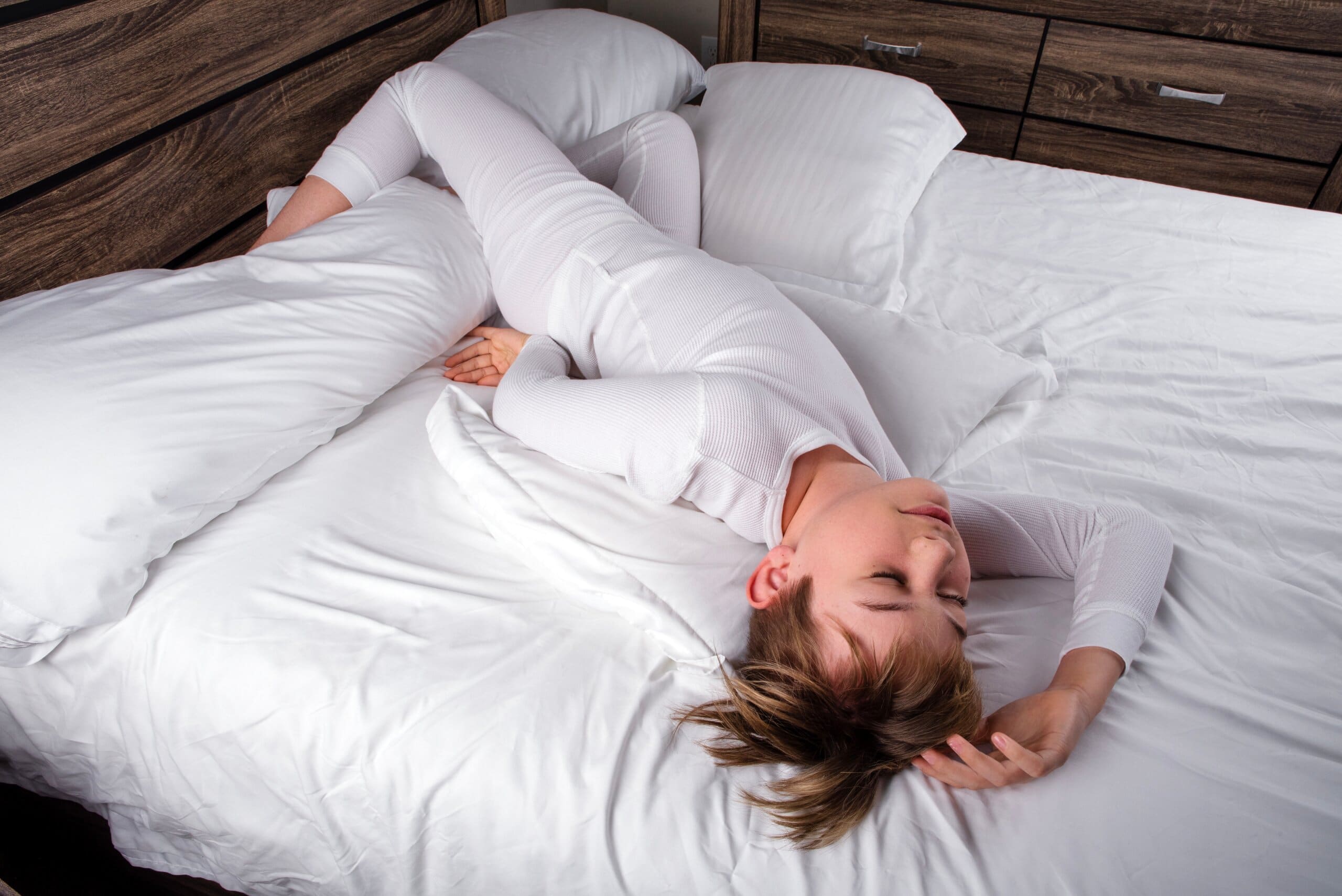As much as we’d like to think it, good posture isn’t just about standing up straight and keeping your shoulders back. And the same is true if you're wondering how to sleep with good posture as well – after all, you spend around a third of your life sleeping, so you might as well get it right!
Needless to say, poor sleeping posture can have a seriously negative impact on your mental well-being, affecting not only your sleep patterns but the health of your muscles and spine.
However, we also know just how difficult it can be to ‘retrain’ yourself to relax into the best sleeping position for posture improvement. But one thing that can certainly make a big difference is the types of mattress material you prefer!
Having a good single or double mattress that works to correct your sleeping posture can go a long way to encouraging and maintaining good sleeping habits. And the sooner you correct your sleeping posture, the better you’ll feel the moment your head hits the pillow after a long day.
Read on to learn the best ways to sleep for posture improvement!

What is good sleep posture?
First off, let’s clarify exactly what ‘good’ sleep posture is. That way, you can learn how to sleep with good posture as soon as possible.
Essentially, when you’re sleeping, you need to be in a position where your spine is adequately supported from your neck right down to the base of your spine. That means keeping your shoulders, hips and lower back properly supported and in alignment, which will allow your spine to sit comfortably in a neutral position with minimal strain.
And not only does such a neutral position keep your spine in alignment, but it also ensures that your internal organs, muscles, and other joints are correctly supported, preventing aches and pains, stiffness, and even muscle spasms from interrupting a good night’s rest.
What is bad sleep posture?
Ok, so we’ve looked at good sleep posture. But what does ‘bad’ sleep posture look like?
Generally speaking, the most widely regarded ‘bad’ posture is sleeping flat on your back (which might come as a shock to quite a few people), specifically without any form of support.
To see why, try lying down on the floor, flat on your back. Even if you try to keep yourself as flat as possible, you can still slide your hand underneath your spine at the base of your back. That’s because your spine is not supported by anything.
So, if you sleep on your back and you have a firm or extra-firm mattress, your spine isn’t being properly cushioned, which can lead to aches and pains down the line due to excess pressure being placed on the discs that sit between each of the spine’s vertebrae.
Not only that, but a flat sleeping position can also lead to pressure points forming along the body, including your hips, head, shoulders, and lower back, with a prolonged lack of support gradually pulling the back out of alignment, which can cause continued pain and contribute to reduced levels of mobility as you age.
It’s important to bear in mind that your spine isn’t just the ‘pole’ that holds you upright. It’s a pivotal part of your anatomy. Anything that affects the spine will have an impact on the rest of your body, from your muscles all the way through to your internal organs.
A ‘bad back’ can be the beginning of a wide range of other ailments and health issues. So, by finding the best sleeping position for your posture, you’ll be looking after the rest of your body too!
How to sleep better for posture
Now that we’ve touched on the impact of poor sleep posture, we can finally turn our attention to improving how you rest at night. And the good news is that the best way to sleep for posture is relatively easy.
It’s simply a matter of ‘retraining’ yourself to adopt a better position and taking a bit of care during the day. For example, you can prep your body for better sleep by doing some or all of the following to improve your posture while awake:
- Stretch and move regularly - try to avoid sitting in the same position for long periods, especially if you work on a computer all day, and make sure you take regular breaks every 30 minutes, if possible. Be sure to also stretch, relax your shoulders, and move around to get your circulation going again if you’ve been inactive for several hours.
- Stand properly – whenever possible, make an effort to stand up straight and avoid slouching, keeping your head level and your ears in line with your shoulders.
- Do posture exercises – if you have the time, try to squeeze in some posture exercises by rolling your shoulders in a circular motion backwards and forwards, while also thinking about more long-term exercises that will help improve your flexibility, such as yoga and Pilates.
These are just a few things you can do to get started. And don’t worry about forgetting them. Simply put a little reminder on your phone to do them regularly, therefore training yourself into some good posture habits!

What is the best sleeping position for posture?
As for the best sleeping position for posture, this will depend on how you currently sleep. Most experts recommend you adopt a foetal position, (sleeping on your side with your knees bent and a flat pillow or cushion between your knees to reduce pressure on your hips).
This sort of sleeping posture is excellent as it naturally elongates the curvature of your spine while reducing the amount of pressure you put on key areas, like your shoulders and lower back.
But if you find it too difficult to change to this sleeping position straightaway, then there are a few different things you can do to improve your posture while sleeping, whether you prefer lying on your back, side, or front:
Side sleepers
Regarded as the best sleeping position, side sleeping in any form can help improve your circulation and digestion while also opening up your airways for easier breathing – which coincidentally is one of our tips for preventing snoring!
If you currently sleep on your front or back then we’d seriously recommend switching to side sleeping as the first step to improving your sleeping posture. Eventually, your body will get used to this and you’ll be able to try sleeping in the foetal position more often.
Read our guide to the best mattresses for side sleepers, which will help you get the best support possible while in this position, further ensuring you've got the correct sleeping posture.
Back sleepers
Although sleeping on your back may allow your head, neck and shoulders to achieve a neutral position, this is only going to be doable if your pillows and mattress properly support your body – which is not an easy thing to do.
At the end of the day, the key to comfortable back sleeping is to choose a medium firm mattress that can keep your back flat without sinking too much. If you prefer an even more firm mattress, think about adding a softer mattress topper as well to provide you with the cushioning you need. Our guide to the best mattresses for back sleepers will give you more information.
However, we would still recommend any back sleepers change to their side as soon as possible, as snoring and sleep apnoea can be aggravated by sleeping this way, and women in the late stages of pregnancy can find undue pressure being put on their internal organs when on their back. If you are expecting and want to improve your posture while you sleep, read our guide on how to sleep better when pregnant.
Front sleepers
Finally, much like back sleepers, we’d encourage any front sleepers to switch to their sides as soon as they can. Much like sleeping on your back, sleeping on your front can put a lot of pressure on your lower back from lack of support, causing it to arch substantially after a while.
On top of this, sleeping on your stomach can also put a lot of strain on your neck, more so if you sleep with your head turned to one side, and can quickly lead to an uncomfortable ‘cricked’ neck.
Therefore, while training yourself to swap postures, and to avoid ‘arched back’ syndrome that can result in aches and pains upon waking, try using a medium-firm mattress. This will help you achieve a flatter or more level spine as you sleep. If you really want to stick to sleeping on your front, at least make sure you have the best mattress for a front sleeper.
How to improve posture while sleeping
Unfortunately, you can't 'fix' bad posture overnight, but there are some things you can do to improve your posture while sleeping. These all involve using a pillow in different ways to support you in the best sleeping posture.
If you sleep on your side, place a pillow between your knees - this will help you align your hips with your spine, preventing lower back pain.
Front sleepers should place a flat pillow under the pelvis - this will help to slightly raise your lower stomach, preventing excess curvature of the spine and supporting your posture as you sleep.
Back sleepers can improve posture by placing a pillow at the back of their knees - this reduces stress on the spine and also supports its natural curvature.
Can your mattress affect your sleeping posture?
As you may have guessed, the answer to this question is most certainly yes. In fact, your mattress can have a huge impact on the way you sleep, and the material your mattress is made from can have a big impact.
For example, memory foam mattresses tend to provide a more cradled level of support as they mould to the shape and contours of your body, helping you to maintain that sought-after neutral spine alignment no matter what side of your body you sleep on.
Pocket-sprung mattresses, on the other hand, tend to be slightly firmer, making them good for front sleepers. But if you want a slightly softer feel, it’s worth combining a firm mattress with a softer topper to create that perfect balance.
Your physical size will also alter how your mattress works to keep you supported. So, the best mattress if you’re larger or have a heavier build will be firmer, to provide greater support for your body throughout the night.
What is the best mattress for correct sleeping posture?
At the end of the day, what mattress is best for your sleeping posture is all down to personal choice, but you do have three main options:
- A memory foam mattress
- A pocket spring mattress
- A hybrid mattress (a blend of the two)
It’s also worth bearing in mind that an orthopaedic mattress is not necessarily going to be the best option for a bad back. Again, it will depend on your sleeping position and your size and weight. If you’re a side sleeper, you may find that an extra-firm mattress is a little too hard. Again, you can soften it down a little by adding a memory foam topper. Our guide to the best mattresses for a bad back will help you out with this.

Find your preferred mattress type with us
And there you have it; you should hopefully now have a much better idea of the best ways to sleep for posture improvement, giving your whole body a new lease on life in the weeks and months to come.
Luckily, you can find your perfect mattress for the best sleeping position for your posture with free next day delivery when you shop with us. If you're still not sure what mattress you need, take our quick and easy MattressFinder™ quiz to be paired with your perfect picks.








